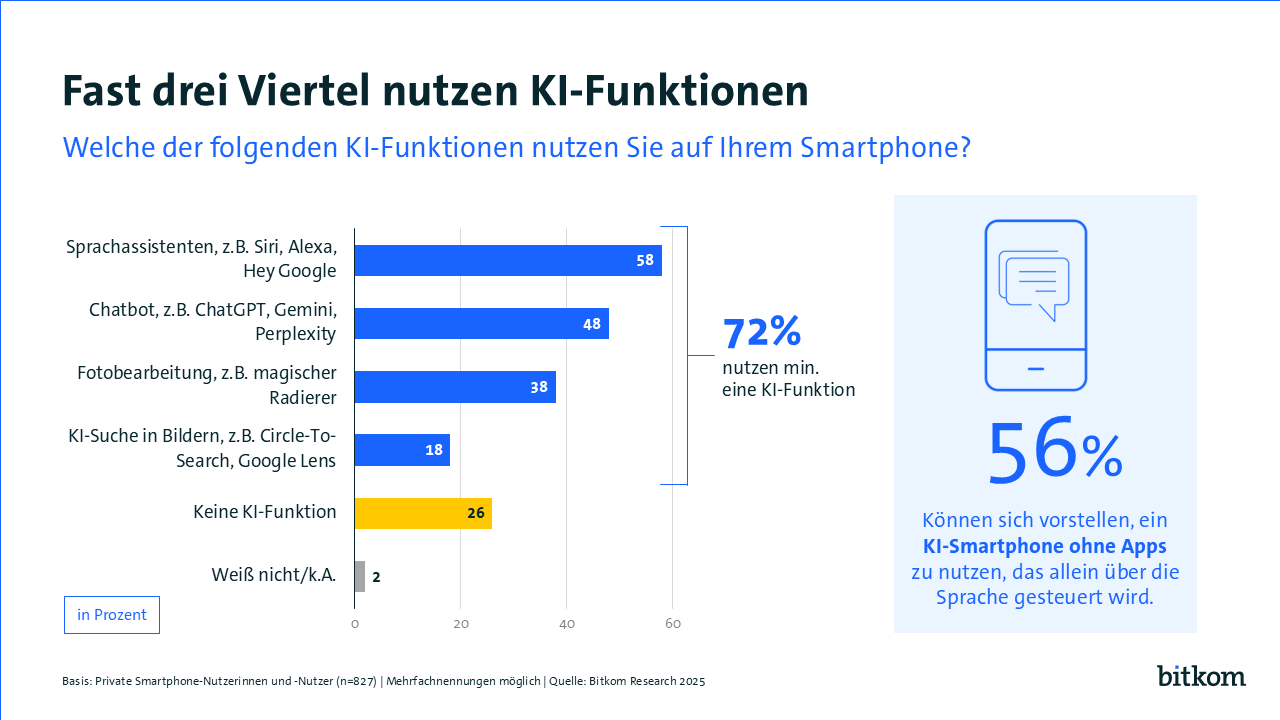AI megatrend: almost three quarters use artificial intelligence on their smartphone. Daily usage time increases to an average of 155 minutes. The Mobile World Congress starts on 3 March in Barcelona
Berlin/Germany, February 20, 2025. The smartphone is indispensable for most users – and many of them are already using artificial intelligence on their devices. The German market for smartphones, apps and mobile communications is benefiting greatly from this and is expected to grow to 40.1 billion euros for the first time in 2025: another all-time high. Compared to the previous year (39.2 billion euros), the increase is 2.1 per cent. This is shown by current calculations by the digital association Bitkom on the occasion of the Mobile World Congress in Barcelona, which begins on 3 March. Data and voice services account for the largest share of sales at 23.5 billion euros (+1.9 per cent compared to the previous year). Smartphones themselves generated sales of 12.1 billion euros (+2.5 per cent).
EUR 2.2 billion (+2.3 per cent) is being invested in the network infrastructure for mobile communication, with costs for frequencies, buildings and construction work being added to this. The app market is growing to 2.2 billion euros (+2.3 per cent). ‘The innovative ecosystem of devices, apps, services and network infrastructure around the smartphone, which is worth billions, continues to grow,’ says Bitkom Vice President Markus Haas. ‘Network expansion is also making great strides forward in Germany: 5G now reaches over 98 per cent of households and over 90 per cent of the country.’ The smartphones themselves are expected to generate revenue of 12.1 billion euros (2024: 11.8 billion euros). Sales will remain stable: according to the forecast, around 20 million devices will be sold in 2025, as in the previous year.
82 per cent of Germans aged 16 and over use a smartphone
Currently, 82 per cent of people over the age of 16 in Germany use a smartphone, which equates to around 56 million people. New functions relating to artificial intelligence are conquering the smartphone market, as a recent representative survey commissioned by Bitkom shows: 72 per cent of those who use a smartphone privately already use at least one AI function on their device: 58 per cent use voice assistants such as Siri, Alexa or the Google Assistant on their smartphone, 48 per cent use a chatbot such as ChatGPT, Gemini or Perplexity on their device. 38 per cent use AI tools for photo editing, such as the ‘magic eraser’, which can make people or objects in pictures disappear. Only a quarter (26 per cent) state that they explicitly do not use any of these AI functions.
People are very open to even more AI: more than half of smartphone users (56 per cent) can imagine using an AI smartphone without any apps at all, controlled solely by voice. Haas: ‘In future, no smartphone will be able to do without AI functions. AI makes smartphones even more intelligent and efficient, facilitates communication and increases productivity. AI is what makes smartphones really smart.’
Half pay attention to AI tools for image processing when buying a new phone
AI tools for image editing such as a ‘magic eraser’ are increasingly in demand when buying a new smartphone. This is already important to more than half of smartphone users (54 per cent) when choosing a new device. However, robustness and the longest possible service life play the biggest role when choosing a smartphone: 98 per cent look for robust screen glass and 96 per cent for a long battery life. 93 per cent consider the amount of storage space to be important and 92 per cent the screen quality. A long-term supply of updates (93 per cent), camera quality (90 per cent) and display size (87 per cent) are also very important to many. Almost two thirds (62 per cent) attach importance to the possibility of voice control – and the price is also an important criterion for three quarters (78 per cent) when choosing a smartphone.
The average price of a smartphone rises above €600 for the first time
The average price per smartphone is rising slightly this year. While an average of 591 euros was spent per smartphone in 2024, this year it will exceed 600 euros for the first time (expected to be 605 euros). ‘Devices are becoming more robust, more durable and of higher quality. Premium smartphones remain in high demand among certain customer groups who are willing to pay a corresponding price for high quality,’ emphasises Haas. On average, users want to spend a maximum of 262 euros on their next smartphone – in 2024 it was 241 euros. However, this is an average value that is made up of both low-cost smartphones with a mobile phone contract and devices without a contract.
Smartphones are no longer being replaced as quickly
People in Germany are using their privately used and self-purchased smartphones for longer and longer and are replacing them with new devices much later than before. Only one in three (35 per cent) still has a device that is less than a year old. In 2024 it was 43 per cent and in 2023 even 55 per cent. Almost half (47 per cent) have been using their smartphone for more than two years. In the previous year, the figure was 27 per cent. The average age of a smartphone purchased in-house is currently 24 months, compared to 17.5 months in 2024. Overall, 73 per cent of those who use a smartphone for private purposes bought their device themselves. 6 per cent use a smartphone as a gift and 19 per cent also use their business device privately. Haas: ‘The more robust and durable a smartphone is, the better the carbon footprint of the devices. It pays off here that manufacturers often use very high-quality materials, the devices are better protected against water ingress or dust than before and are supplied with software updates for longer. In addition, more efficient battery technologies and optimised software reduce battery wear.’
More than 2.5 hours of smartphone time per day
Smartphones are now in daily use for significantly longer than before. The younger the users are, the more time they spend on their device. On average, 16 to 29-year-olds use their device for almost 3.5 hours a day – a total of 212 minutes. Two years ago (2023), the figure for this age group was 177 minutes. The 30 to 49-year-olds estimate their daily use at an average of 158 minutes (2023: 151 minutes) and the 50 to 64-year-olds at 148 minutes (2023: 144 minutes). The average usage time for senior citizens over 65 has also increased significantly and now stands at 103 minutes – 23 minutes more than in 2023 (80 minutes). Across all age groups, the average daily smartphone usage time is 155 minutes (2023: 143 minutes).
82 per cent of smartphone users can no longer imagine life without their device. 66 per cent feel safer in everyday life as a result. However, there are also frequent feelings of annoyance or discussions when others feel that the smartphone is being used too intensively: 73 per cent find it annoying when other people only look at their device during a meeting. 63 per cent are also annoyed when even small children use a smartphone.
Good reception, high network coverage, fast surfing
When it comes to choosing a mobile phone provider, mobile phone users largely agree on the criteria again this year. Practically everyone wants good reception at their place of residence (96 per cent). The widest possible network coverage (95 per cent) is important to just as many and 90 per cent want the fastest possible surfing speed. Prices should be as low as possible for 76 per cent and good customer service is important to three quarters (75 per cent) when choosing their mobile phone provider. This is followed by flexible cancellation options (71 percent). The sustainability of the mobile phone provider (68 per cent) and the company’s social commitment (52 per cent) also play a major role.
Even though good reception and good network coverage are important criteria for practically everyone, the acceptance of new radio masts for further network expansion is less developed, but here too, support is increasing: 61% are in favour of erecting further masts for network expansion and 35% are against. Five years ago, opponents and supporters were still on an equal footing: in 2020, 48 per cent were against and 48 per cent in favour of erecting more masts. 58 per cent currently say they feel safer when their surroundings have good network coverage – and half (49 per cent) are in favour of allowing radio masts to be erected in nature reserves to ensure comprehensive network coverage.
Although 37 per cent are in favour of mobile phone expansion overall, they do not want a radio mast near their home. Haas: ‘The Federal Network Agency’s current deliberations on future coverage requirements envisage that each of the three established network operators will cover 99.5 per cent of the entire area of Germany by 2030. To achieve this, even remote areas that are difficult to access, such as mountainous regions, nature reserves or coastal areas, must be able to be supplied with high-speed mobile communications.’ It is therefore important that the network expansion is certified as being in the ‘overriding public interest’ without restriction and for an unlimited period of time. ‘The overriding public interest is what makes accelerated and nationwide expansion possible in the first place. This addition allows the approval authorities to prioritise the expansion of telecommunications networks when weighing up nature conservation or monument protection,’ explains Haas.
Mobile network expansion: speed up procedures, streamline bureaucracy
With annual investments of over 13 billion euros, network operators in Germany are driving forward the expansion of mobile communications and gigabit. 5G reaches over 98 per cent of households and covers almost 90 per cent of the area, 76 per cent have access to a gigabit connection. ‘The telecommunications companies have set a fast pace in the gigabit expansion. But in order to fulfil the political targets, the next federal government must remove the remaining expansion hurdles,’ says Bitkom Vice President Haas. This includes, among other things, the creation of a genuine European single market for telecommunications. ‘Germany must advocate more harmonisation at European level and reduce national differences, for example in security and consumer protection requirements.’ There also needs to be a drastic reduction in bureaucracy within Germany and simplified authorisation procedures for the construction of new radio masts. In addition, Germany must massively expand its capacity for innovation by supporting the development of key technologies such as 6G and Open RAN as the basis for the mobile communications of the future.
And finally, state investment in gigabit expansion should be reduced – from Bitkom’s point of view to a maximum of 1 billion euros per year. Haas: ‘Germany must limit public funding for network expansion to areas that have no private-sector expansion prospects. If too much public funding competes with private funding, scarce construction and planning capacities will be tied up in subsidised projects and will therefore no longer be available for faster expansion by the private sector. Network operators do not want more money from the state, they want less bureaucracy and more entrepreneurial freedom.’
ImageSource
Bitkom


